[ page 2 ]
1/72 scale kits of the MiG-17 (NATO "fresco")
(NOTE: the models shown here were made years before the Airfix kit appeared).
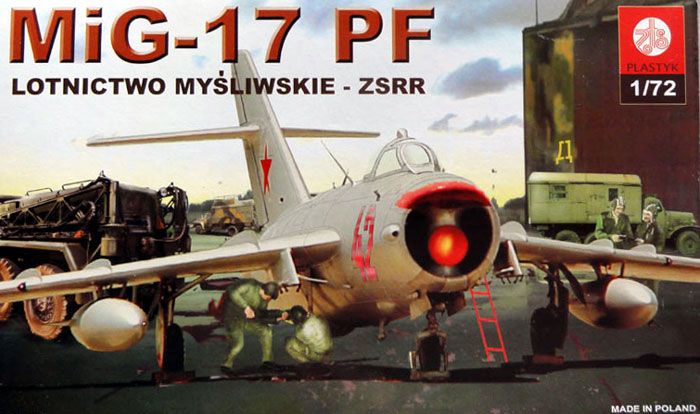
The first 1/72 MiG-17 kits made are from ZTS Plastyk. The MiG-17PF kit has appeared in different boxes. But the contents, except the decals are the same. Kit #S-037 has decals for a USSR Soviet MiG-17 in bare metal.
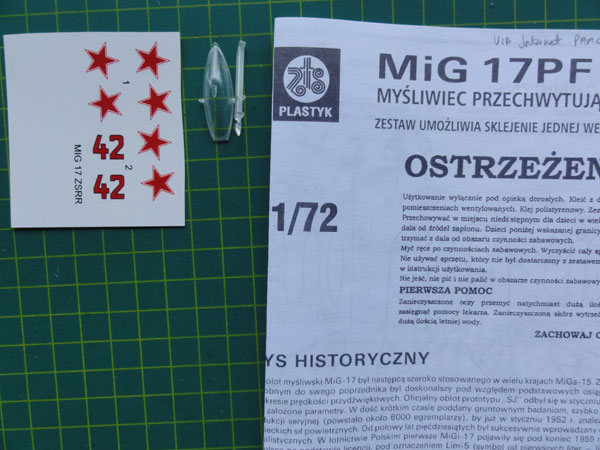
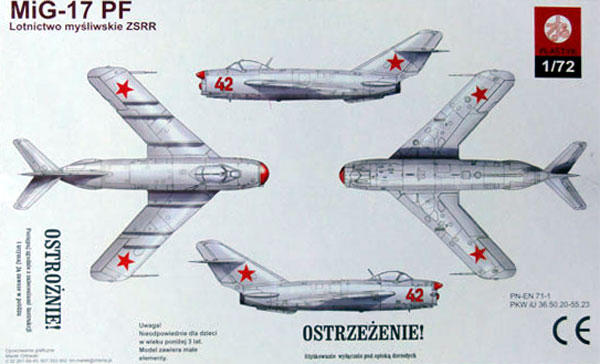
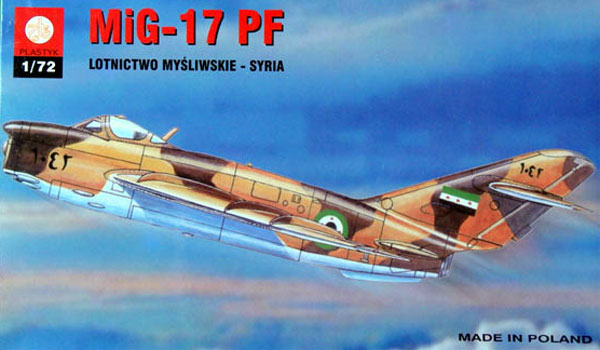
Kit #S-024 has decals for a desert camouflaged Syria Arab air force aircraft of 1973. Note that also the USSR Soviet scheme was shown on the kit box but I did not find the decals inside.
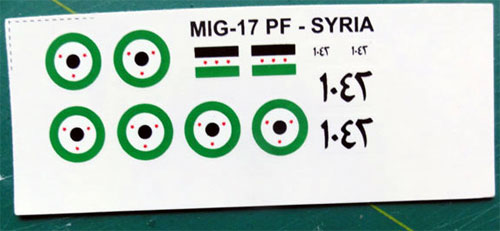
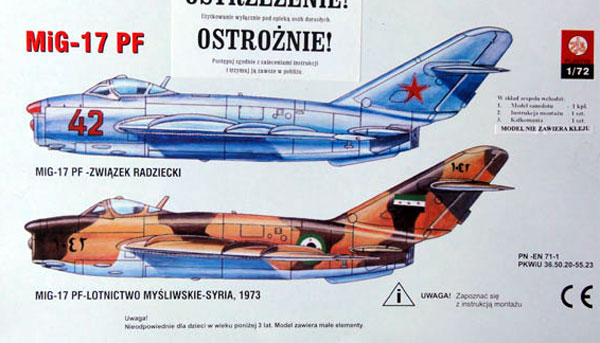
In the ZTS Plastyk kits, some 40 parts in light grey are in the sprues. The panel lines are inscribed but a bit deep or irregular in areas. The nose section is a bit longer as appropriate for the PF. Also, it has a one piece closed canopy that is a bit longer and has the extra horizontal frames as of the PF. Is also has the rear view mirror fairing.
(Observation: it seems the kit parts are a copy of the KP 1/72 kit, but re-arranged and now with inscribed lines).
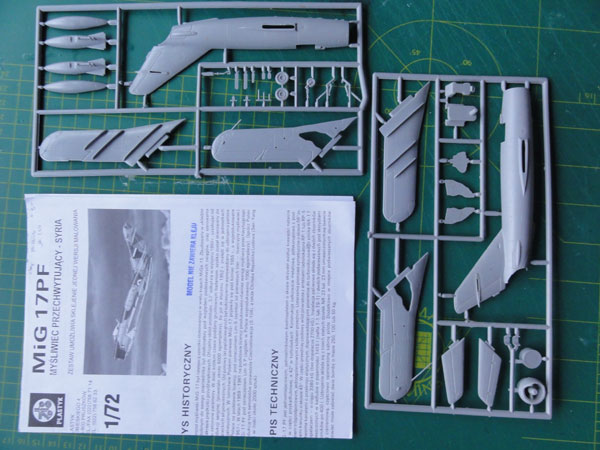
I wanted to check accuracy looking at wing and main shapes. Although one should always take care with scale drawings, I used a Russian drawing to verify accuracy. This was made by clearly a few specialists as it also shows details of structure and so on, the source is however unknown. Also, I looked at photos of the real aircraft and had also several publications like IPMS U.K. magazine #1992-3.
First I made sure the Russian drawings were 1/72 and than compared the kit parts (note parallax due to camera lens so used "eye ball mark one").
As the kit is for a MiG-17PF "Fresco D" and the nose section for a PF is a bit longer (about 2 mm in 1/72) do not compare that kit section here with the drawings. All seemed correct in this PF kit.
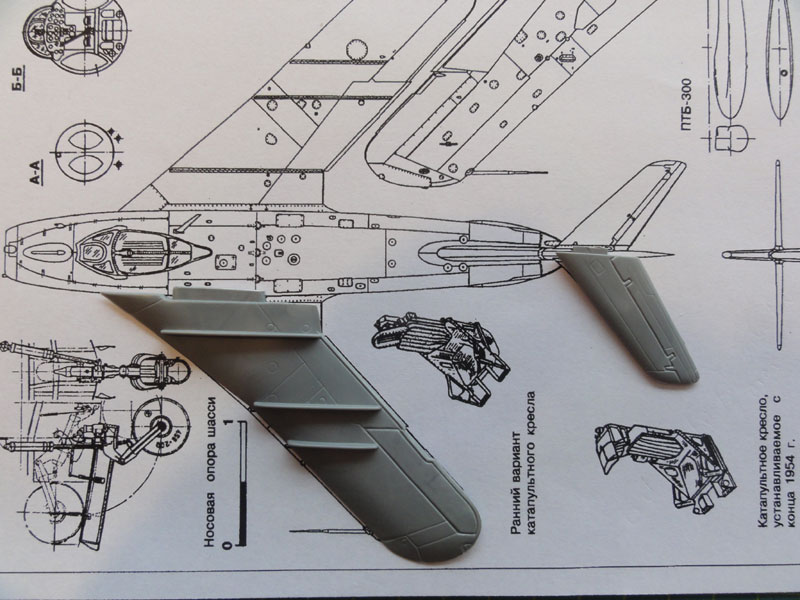
Note: the top view here is for a MiG-17F and shows the common wing and stabilizers as well as the main fuselage.
- the wing planform seen as from above looks good but the wing span is about 3 mm too large. This can be corrected by sanding off the wing tips about 1,5 mm in a curve. (the strange engraved lines near trailing edge will be filled).
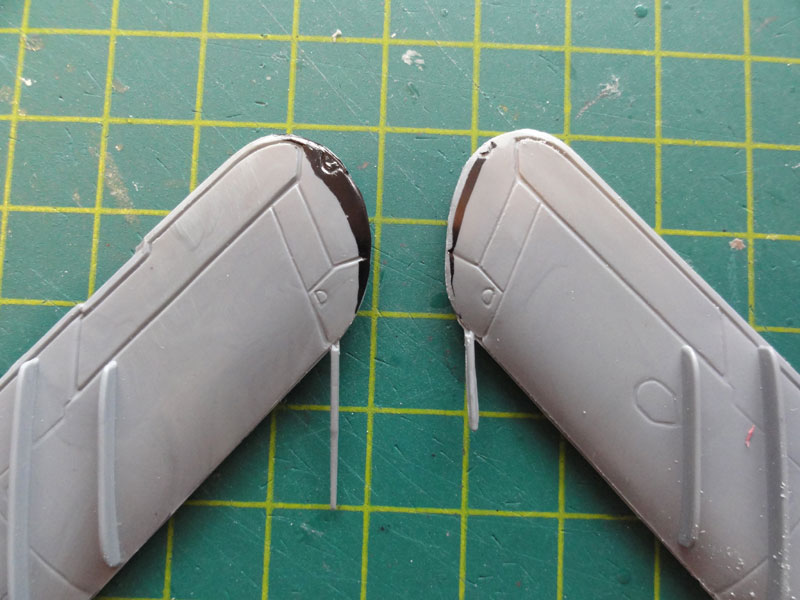
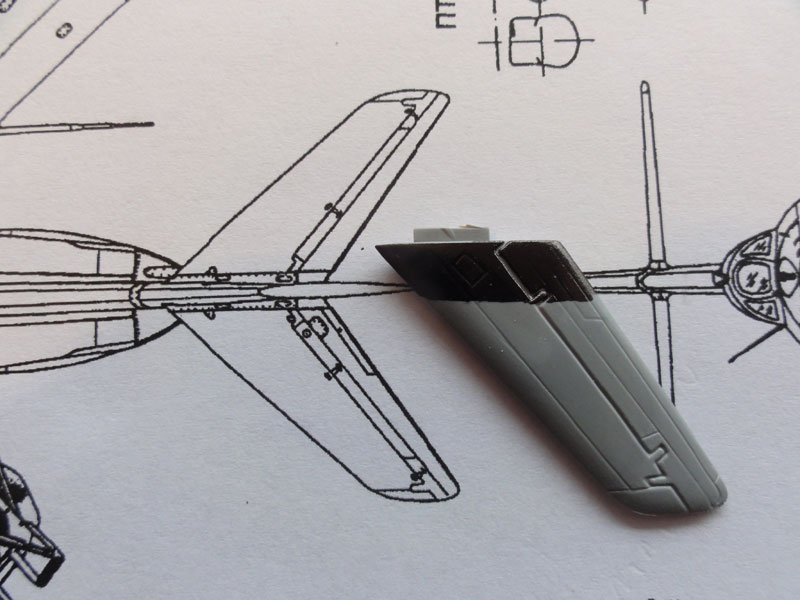
- the horizontal tail planes are MUCH too large. I removed the inboard section (painted black here) with a razor saw. It was also sanded to get a bit more tapering.
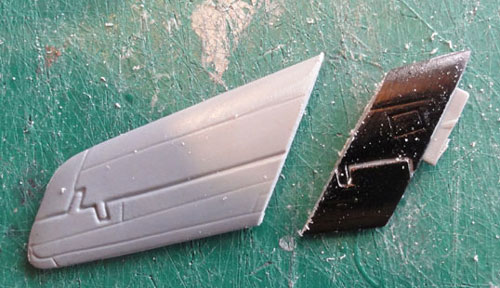
Tail and vertical fin:
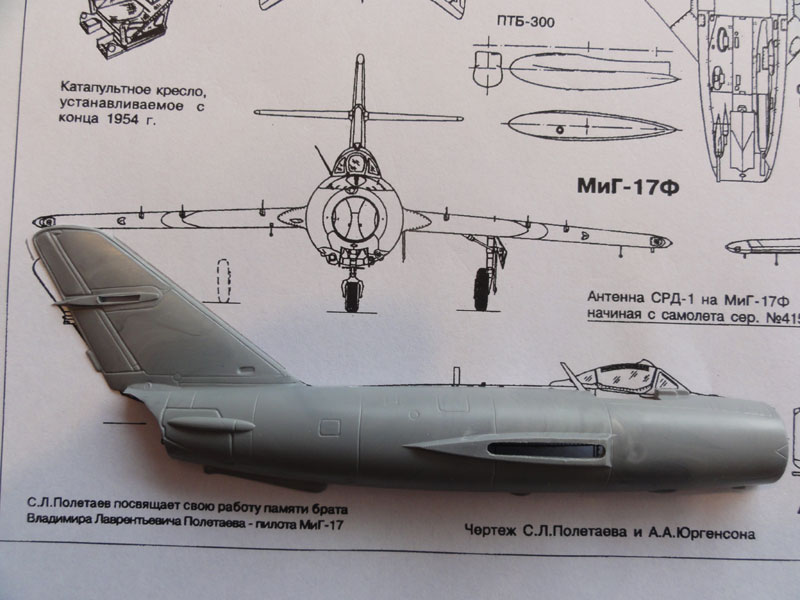
- vertical fin has an incorrect sweep angle and is over sized, this can also be seen when comparing the kit with real MiG-17 photos. Correcting this needs significant surgery. The kit part outline is seen drawn in pencil below...
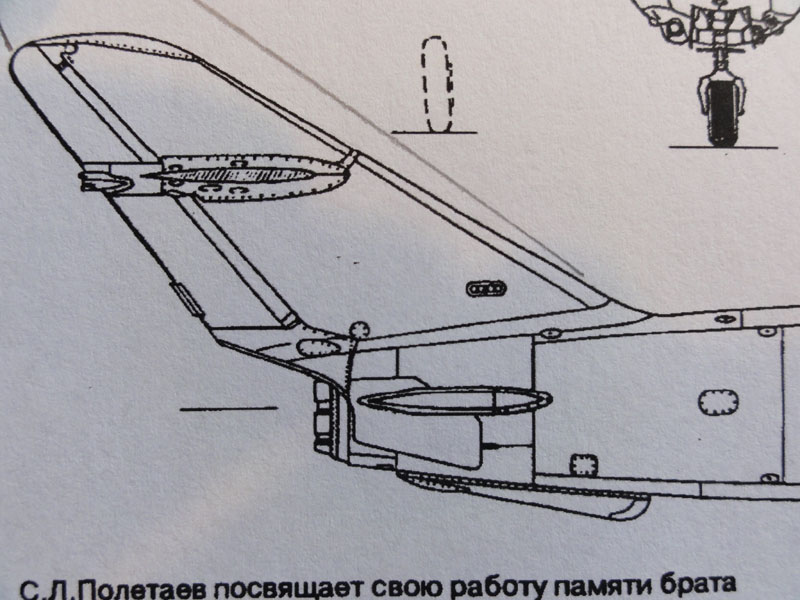
First I removed the entire vertical tail with a razor saw. (both halves)
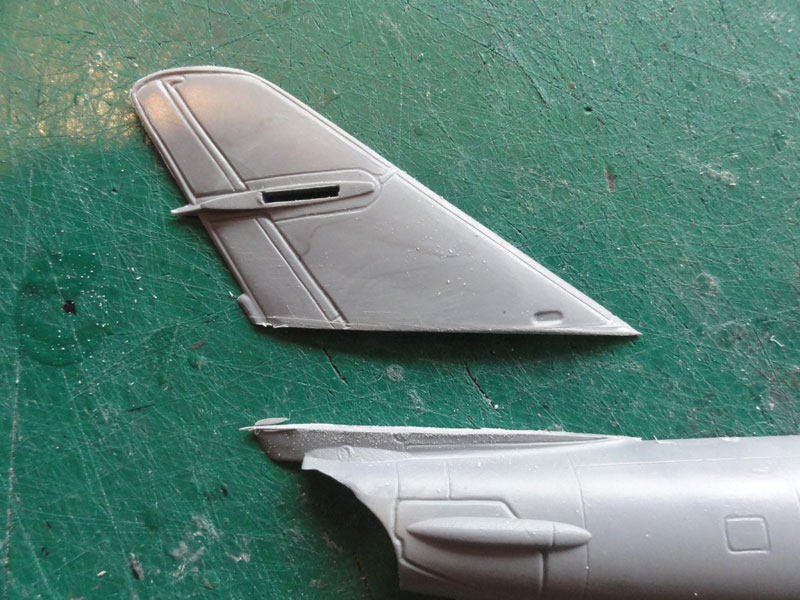
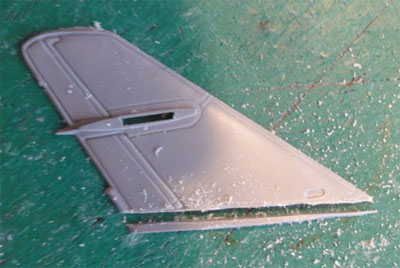
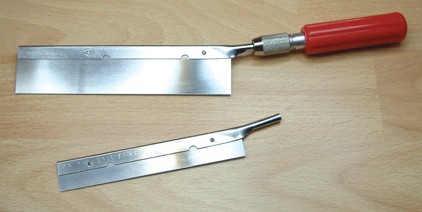
The next step was to remove at the root a section of both halves in a tri-angular way. This improves both size and sweep. Seen also below is the later used larger type MiG-17F or PF air brake.
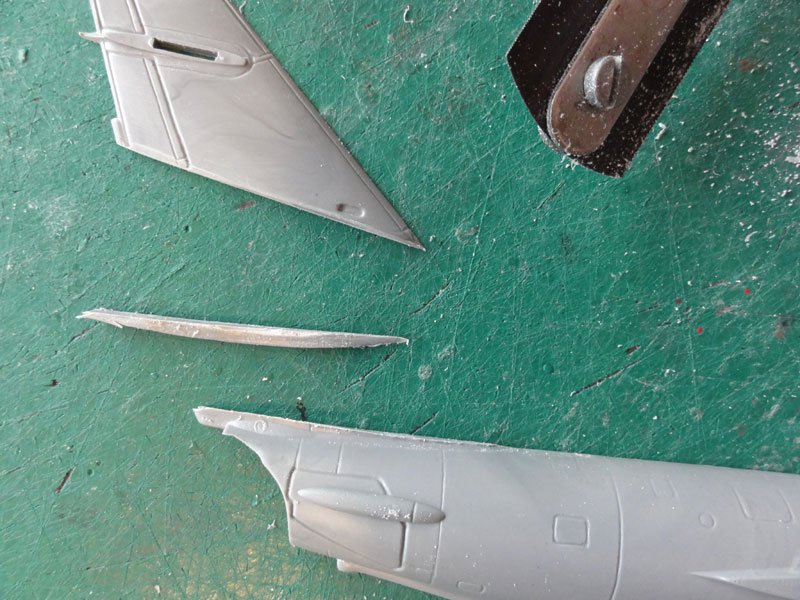
Note that the angle of attack of the lip of the horizontal stabilizers is also affected by the changed angle. So...
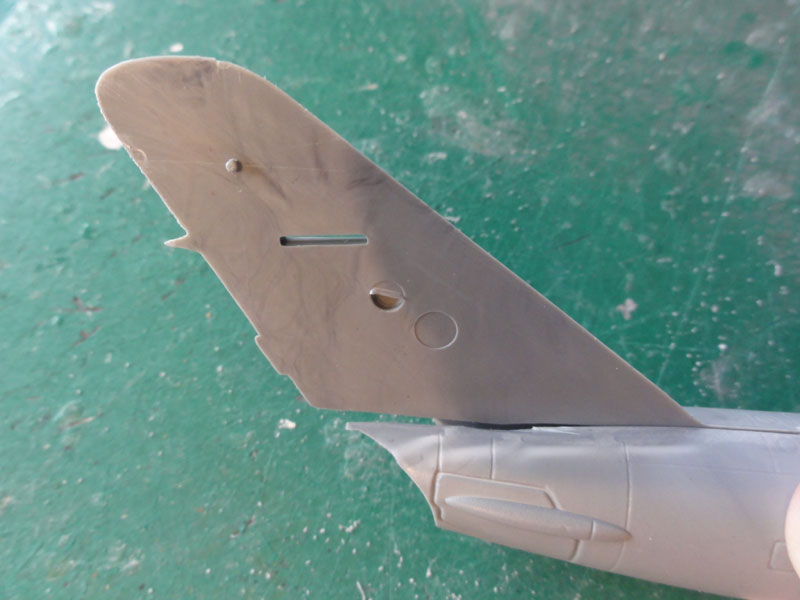
... new horizontally positioned stabilizer root fairings made from card.
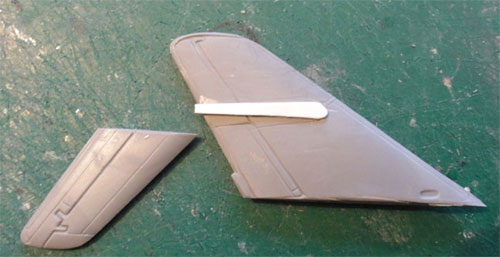
The cockpit is basic so a few extra details were added such as a rear bulkhead aft of the seat. From the instrument panel, 2 mm had to be removed to get it to fit.
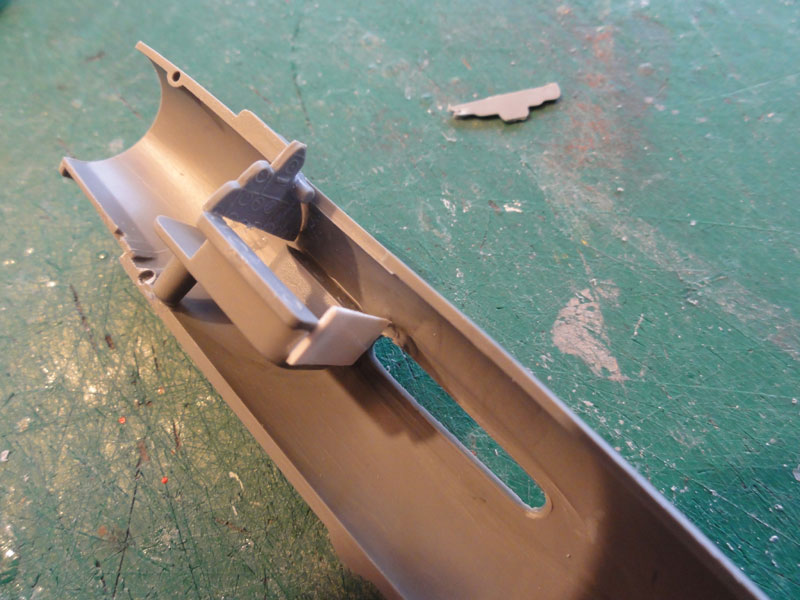
The seat was also improved a bit. (note that also after market resin seats are available). Cockpit interior and instrument panel was mainly mid grey with black details and brown seat cushions usually. Gear bays and legs were "gloss" medium grey as were most wheel discs.
Seat straps will be added later on. Nose weight to avoid "tail sitting" was also added inside though there is not a lot of room. (On hind sight, I should have added more nose weight inside).
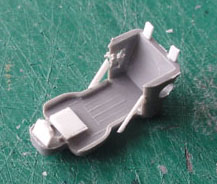
The nose section is also a bit longer in this PF kit which seems correct (about 2 mm as compared to the earlier MiG-17 and MiG-17F).
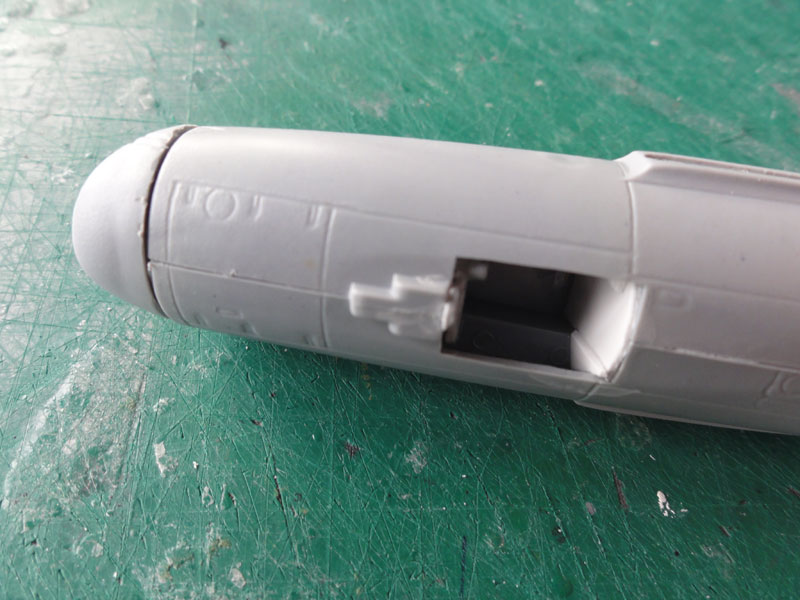
The nose ring #9 in the kit is moulded closed so it was cut open to suggest the large air intake. The nose gear bay was also cut out and boxed in with card (not seen here).
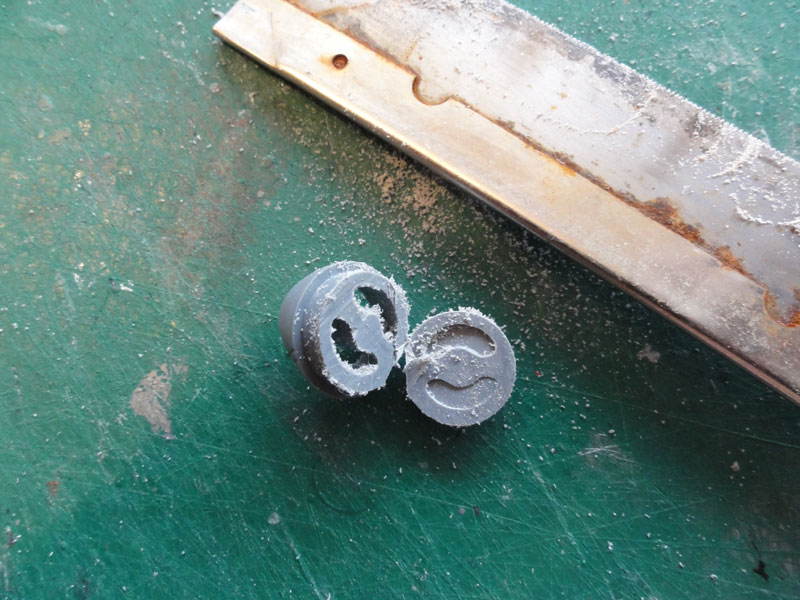
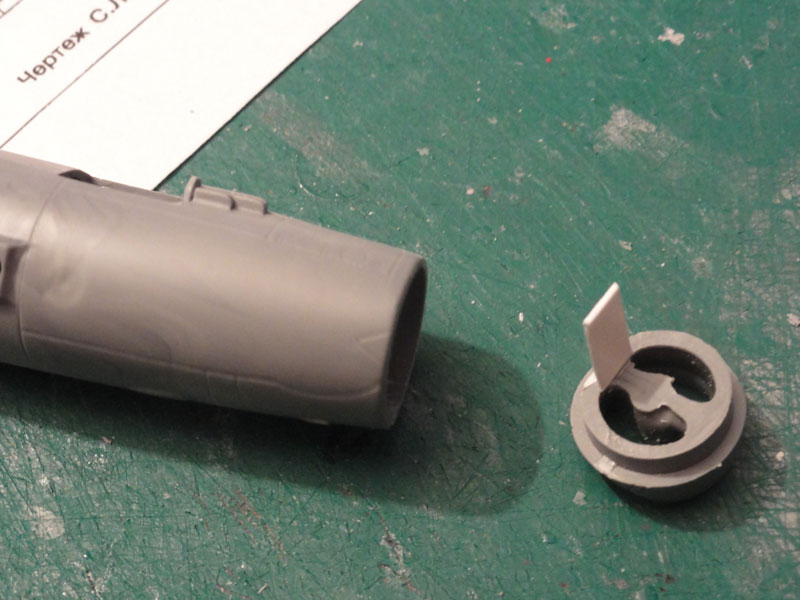
I did not make a full intake funnel, just black paint inside and a small piece of plastic added. The fuselage was now assembled, puttied and sanding was needed.
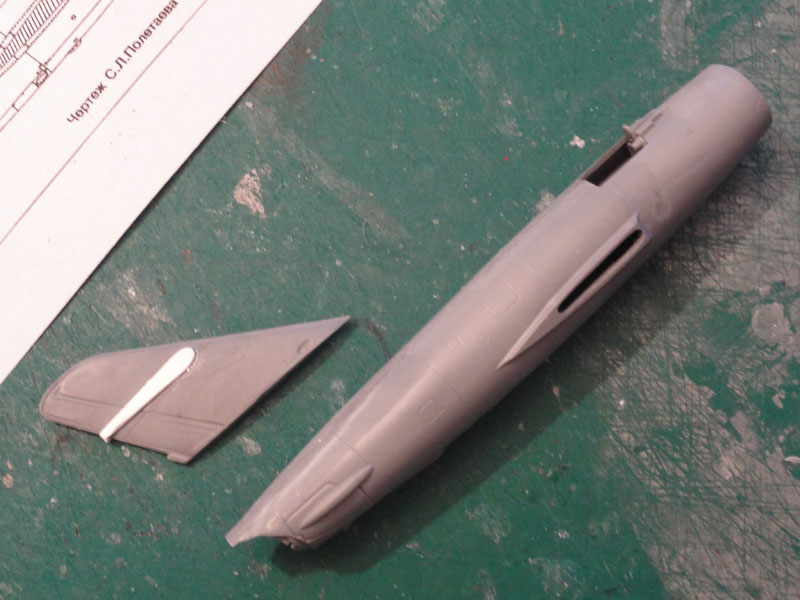
Note the new horizontally positioned stabilizer root fairings made from card.
The kit PF nose intake ring is set and needs putty and sanding.
On the wing, the strange engraved lines at the aileron trailing edges were also filled and sanded to remove these.

... and after sanding ....
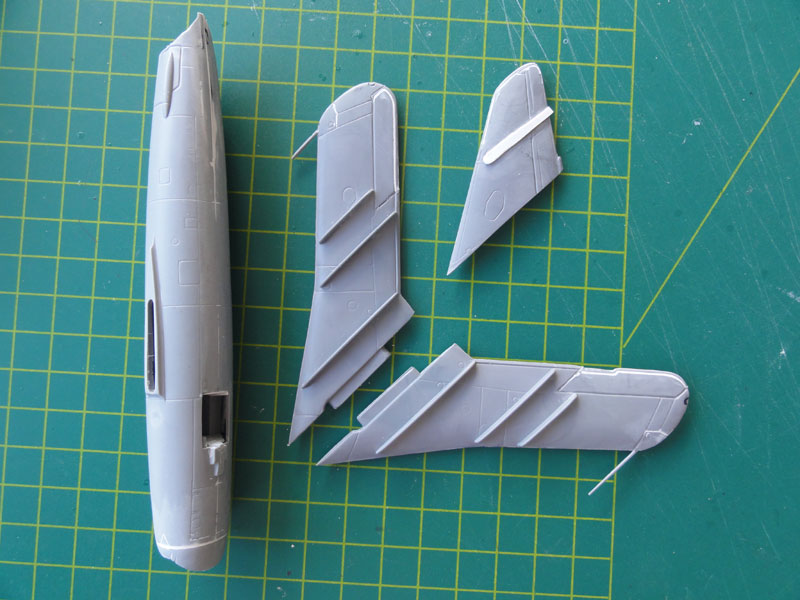
These are the major improvements to the ZTS Plastyk kit in overall size and look.
The main parts were set together and the model got another round-up of putty at wing roots and tail followed by sanding. The wing has a small dihedral angle.

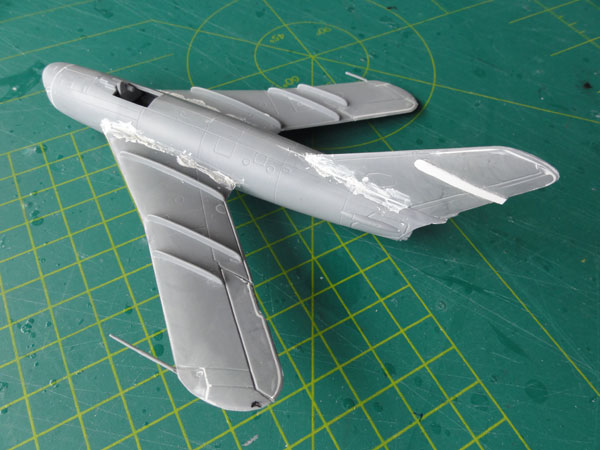
The stabilizers were also set and some other rescribing was done at the surface joints to get panel lines restored.

To complete this stage, a base grey coat was airbrushed to check for any flaws.
Here a comparison is shown of canopies of Plastyk, AZ Model and a Pavla vacuform after market one:
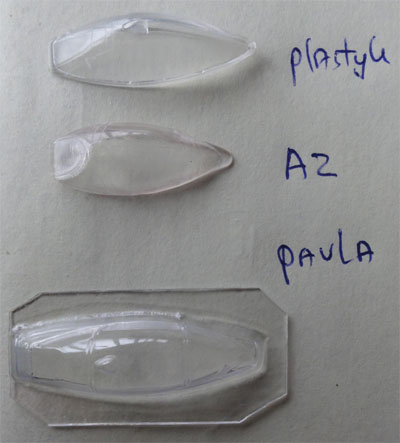
The ZTS Plastyk canopy with wind screen is for a PF with extra horizontal frames and is a bit longer. I will open up the canopy with the TIGER razor saw, sanding it at the edges. This canopy has the rear view mirror fairing on top, some aircraft did not have this.
The separated canopy windshield was set in place also with white glue to close gaps.
The landing gear is very simple in these kits. I bended the out door strut at the main gear leg a bit as the door is set at an angle.

The pitot tubes at the wing tips were made from metal needles, this looks much better.
These improvement steps to the ZTS Plastyk MiG-17 were done for all 3 kits made.
Page 2
Page 3
Page 4
The first MiG-17PF "Fresco D" model was made of the Syria Arab air force. Besides some 60 MiG-17F delivered, an unspecified but probably some 20 of MiG-17PF "Fresco-D" jets were delivered end 1950s. They were operated within the Syrian component of the United Arab Air Force (with Egypt) in 1958-1961. They were quickly after the Six-Day war with Israel.

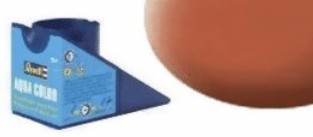
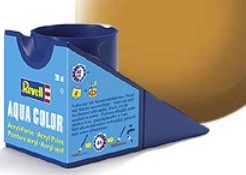
The desert camouflage pattern was used as shown in the kit instructions. Acrylic paints were airbrushed: first, the lower grey colour was airbrushed with Gunze Sangyo H337, approx. "FS35237". (sometimes Syrian MiG-17's were also painted admiralty grey on the lower surfaces or light blue). The sand colour was Revell Aqua 88 approx."FS30219" and the darker brown colour Aqua 85 "braun" approx. FS30118.
All Aqua paints are very thick in their blue container; I always thin Aqua paints with a mix "of 25% IPA (iso propyl alcohol) with 75% distilled water" in a ratio of thinner mix 1:1 paint.
Some masking between colours is needed.
Gear bays and legs were painted "gloss" medium grey.
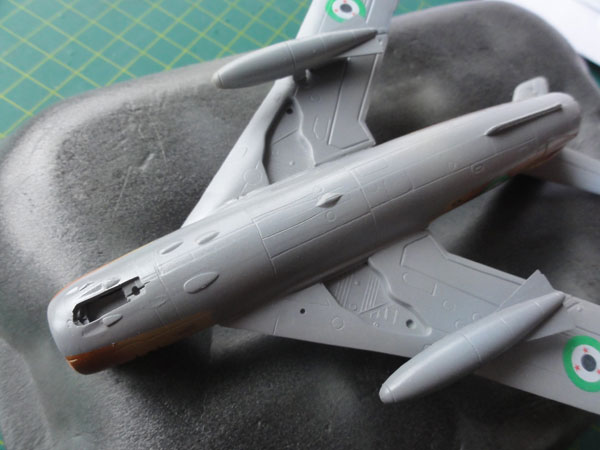
(Note in the photo the deepened nose gear bay). The wing fuel tanks were also used and installed but the attachment part #22 made a bit smaller to get a correct pose.
The areas in the cockpit were painted in the typical MiG interior green though not sure if this was used on this Syrian MiG-17. (I later found at it should have been medium grey). The decals were in the Plastyk kit with the old style Syria AF / UARAF roundels.
The PF windscreen (with small extra horizontal frames) was fixed with white glue, this closes tiny gaps, paint when dried. The separated rear canopy set slides open.
At the canon, the barrels were made from bits of metal from a needle. (The MiG-17 does not have a long wire antenna like the MiG-15 so this was not needed).
The model got a mat varnish coat airbrushing a mix of Johnson Future / Pledge with 20% Tamiya matting acrylic X21 "Flat base" mixed in (cover of the glass work when applying this).
That completed this special Syrian MiG-17 PF.
SYRIA

 ..
..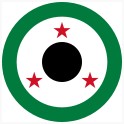 ..
..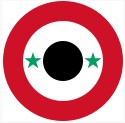
The Syria air force "القوات الجوية العربية السورية, Al Quwwat al-Jawwiyah al Arabiya as-Suriya" saw beginning 1957 the delivery of some 60 MiG-17F including probably some 20 PF with radar (also from DDR and Poland) and also a dozen IL-28 bombers were delivered.
February 1958 it was decided to create a joined "United Arab Republic" with Egypt with a single joint UAR air force. Many Syrian aircraft were based in Egypt at the time. In Syria, most MiG-17's were based at Almezzeh. A coup d'etat in 1961 saw the UAR disbanded with years of unrest and in 1963 the Ba'ath Party taking over power in the country.
More info about the Syria A.F is seen on the MiG-21 page here...
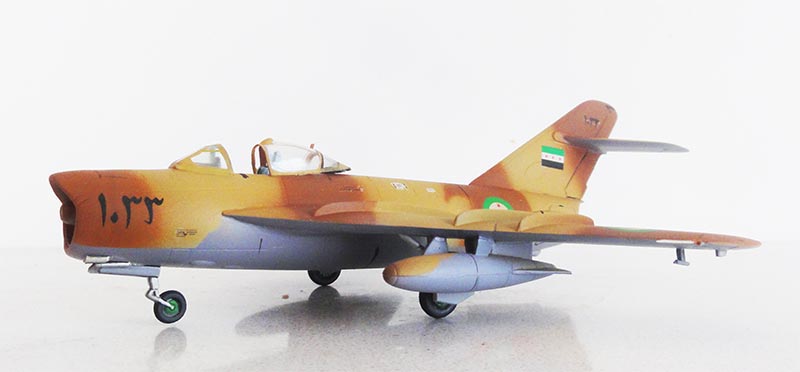
MiG-17 PF "Fresco D" "1022" of the Syria Arab air force "القوات الجوية العربية السورية, Al Quwwat al-Jawwiyah al Arabiya as-Suriya" .
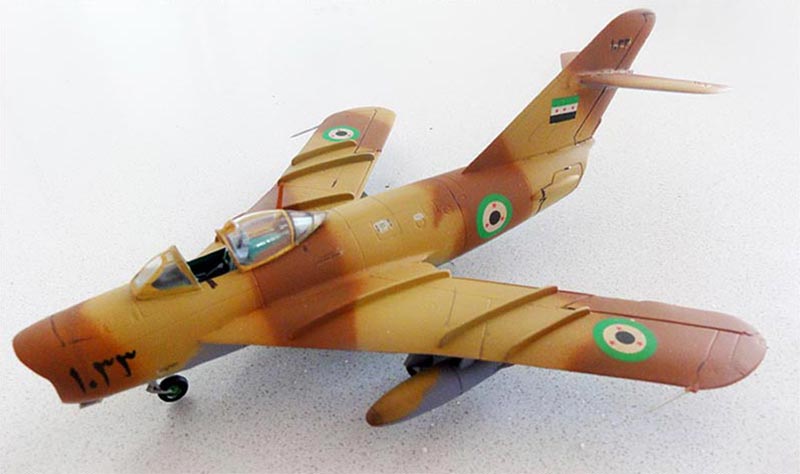
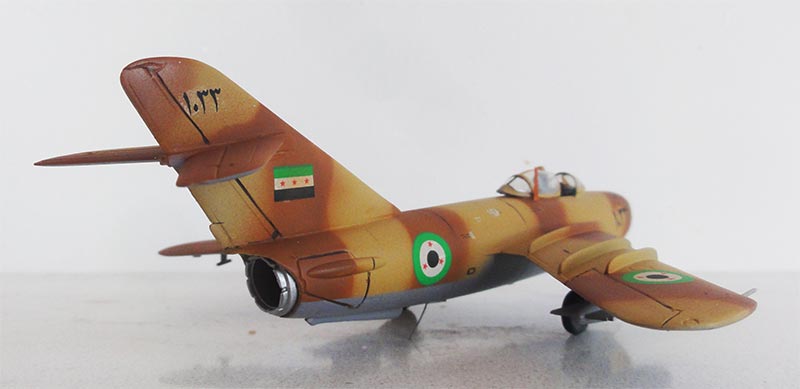
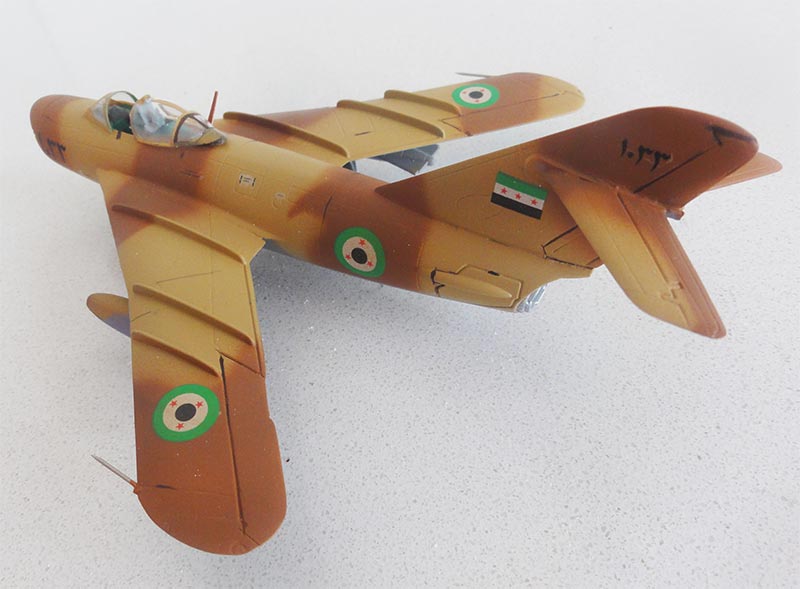
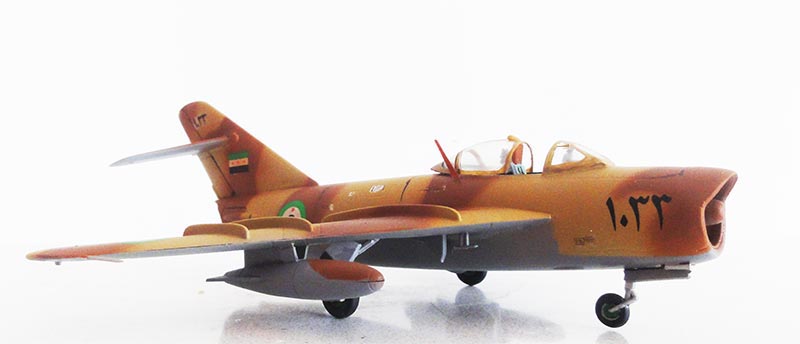

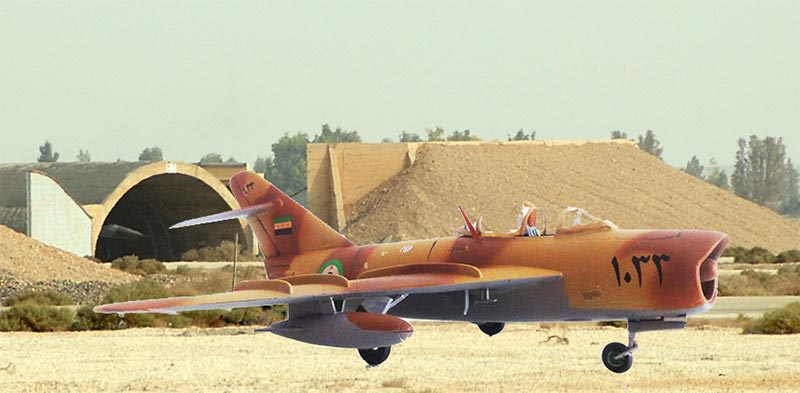

The next MiG-17PF was made with another Plastyk kit S-037. This was done in a similar fashion as described above for previous MiG-17PF. The PF has the longer nose and also the longer windscreen with extra frames.
The model was made for an Indonesian "Angkatan Udara Republik Indonesia (TN-AURI)" MiG-17PF. Indonesia obtained Polish license made Lim-5 PF jets from 1958 and they could be fitted with four "PC-1-Y" missiles set on large pylons.
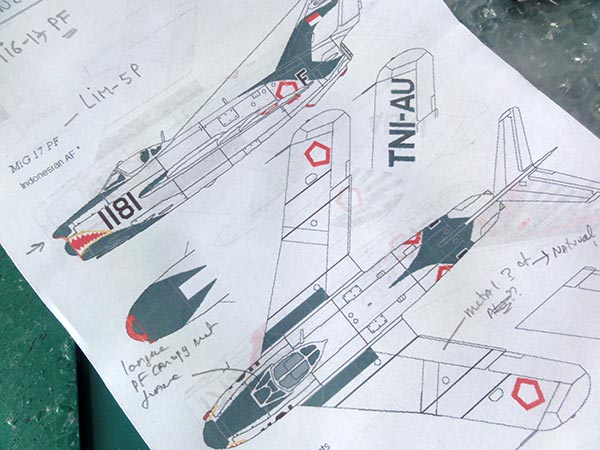
This Indonesian MiG-17PF / Lim-5P had a very nice paint scheme with a shark pattern on black on a natural metal aircraft. I had very nice decals from PrintScale set 72-008 with this scheme with "bort no. 1181". It was seems a demonstration aircraft, but details could not be found though probably flown in the 1960s by SkU 11.
The main improvements also with this kit were also done as noted above....
The MiG-17 was fitted with the KK-2 ejection seat. A resin KK-2 seat from TEMP Models set 72010 was used. Most MiG-17's used this type of seat which differed from the earlier KK-1.
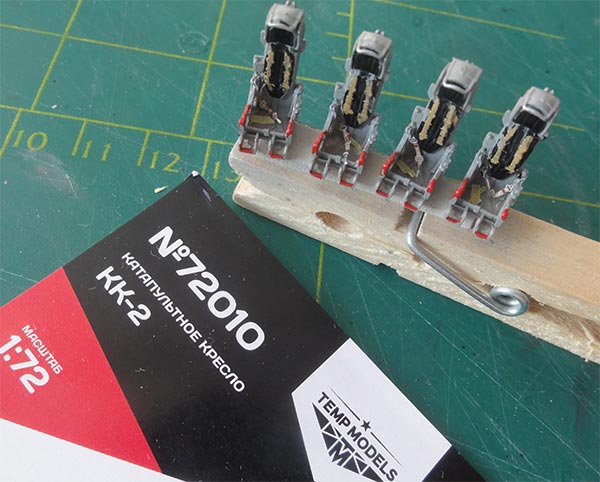
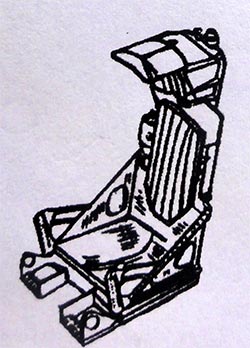
The seat has often black cushion/ parachute pack and black head rest; seat straps usually olive and/or medium brown. Red details are seen on the seat. The other cockpit interior colours are mainly medium grey.
The model first got a black base gloss paint.
Next, the shark pattern was masked off on both the rear fuselage but also the panels on the nose as well as the anti-glare panel and the walkways on the inboard wing.
The paint scheme is overal "natural metal alodine". For this, ALCLAD II ALC-101 aluminium was airbrushed over a gloss black undercoat.
On real MiG-17's, some different shades of panels are seen. This can be simply accomplished with this trick:
-1- at these panels set masking tape in the appropriate panel shape;
-2- airbrush a first coat of ALCLAD. After a few passes, remove the tapes.
-3- Add another few paint coats in a few passes; the results are a few different coloured panels.
Do not forget the smaller parts like gear doors. I also installed the outboard tanks


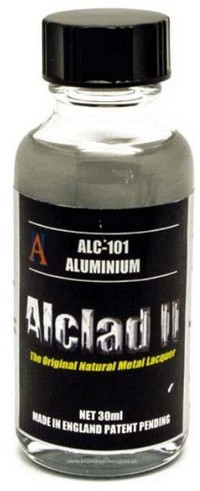
IMPORTANT: Wear a face mask when airbrushing ALCLAD!
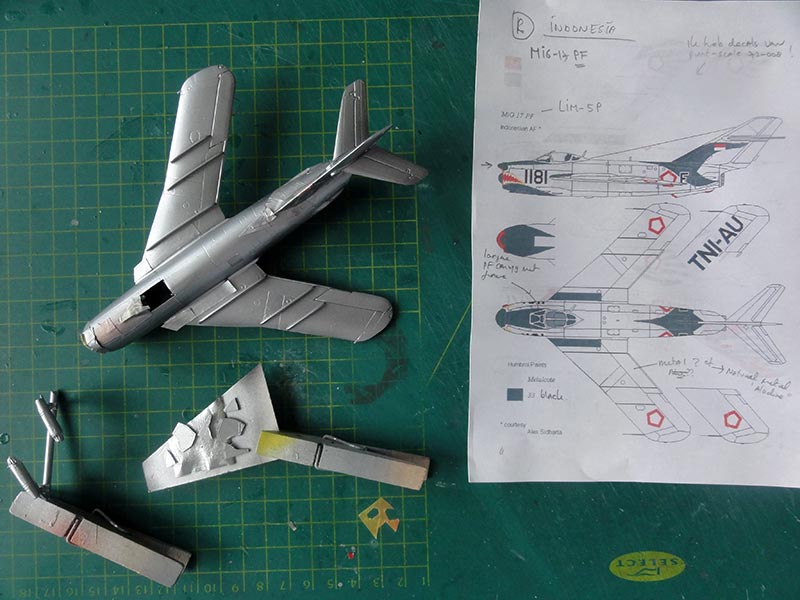
The paints were glossy so the PrintScale decals could be set next.
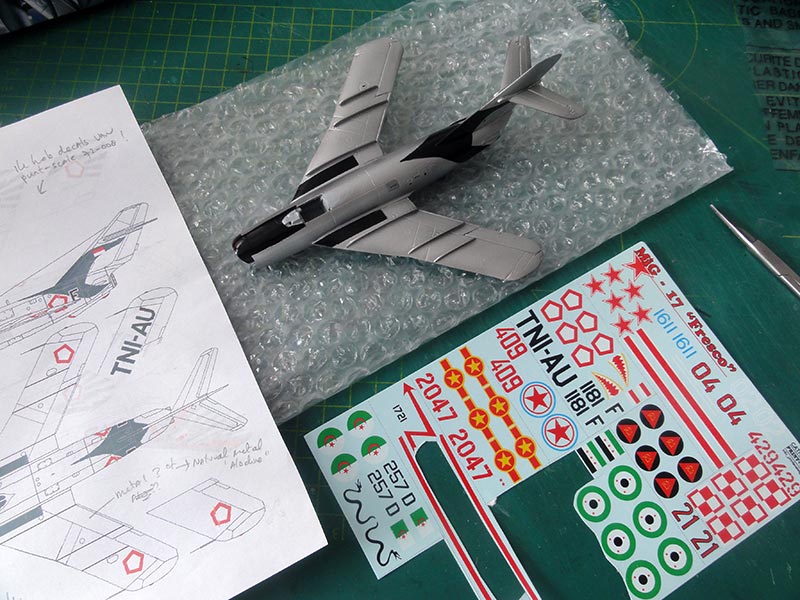
The undercarriage was installed.
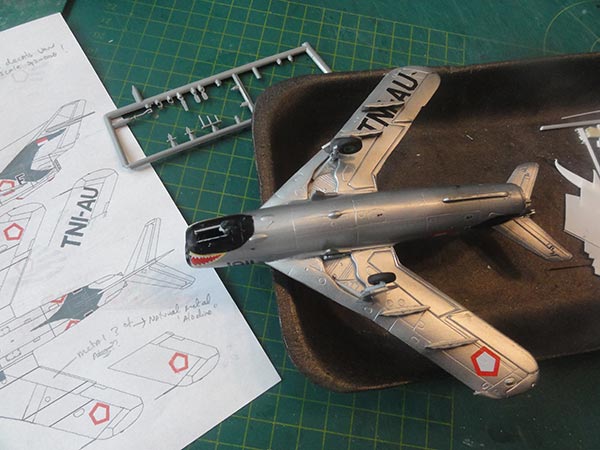
The coaming with a sort of sight was detailed a bit and TEMP seat installed.
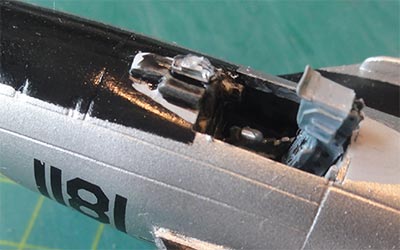
The longer windscreen of the PF with extra frames was obtained from a PAVLA vacuform canopy. This looks much better as the one in the kit. The rear sliding canopy was obtained from a spare Airfix kit canopy. The canopy frames were handpainted.
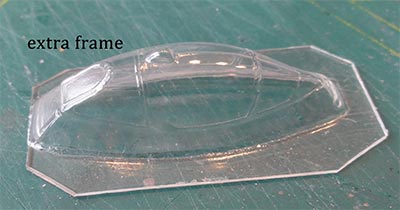 ..
.. 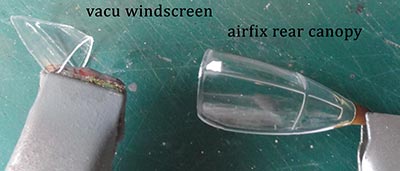
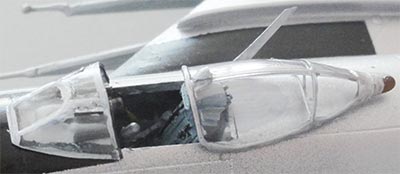
A small blade antenna was fitted on the spine as well as the standard antenna next to the cockpit.
For the model it was decided later on to added the typical missile pylons, that would be nice extra to suggest the used armament.
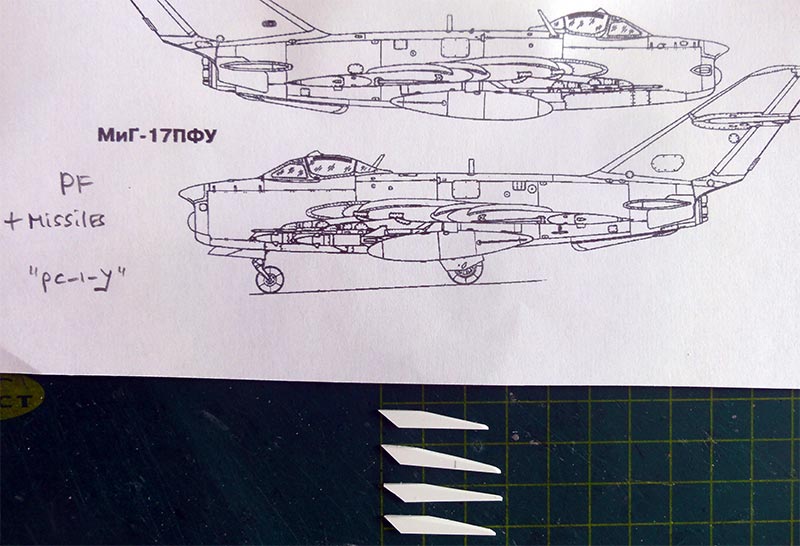
The missile pylons had to be made from scratch. Russian scale drawings were used as pattern and thick plastic card. The 4 pylons also have an anti-flutter stick and weight. These were brush painted.
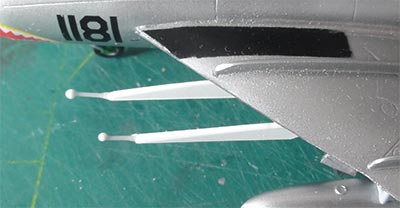
The missiles I could not yet find, so the model has empty pylons. Where to find these???
The model got finally a gloss varnish airbrushed with Johnson Future / Pledge to get an even sheen and protect the decals.
INDONESIA
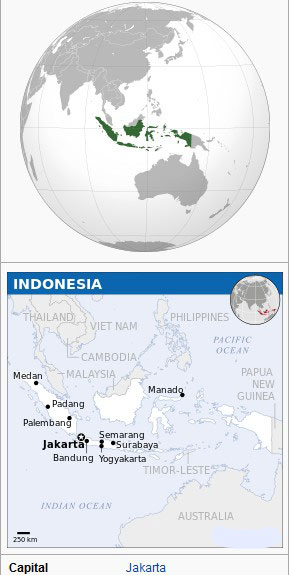

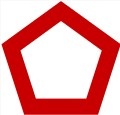
After the end of the Second World War Indonesia fought a war to gain independence being a former Dutch colony. Nationalists under leadership of Sukarno declared independency on August 17,1945. Militia used a few Japanese abandoned aircraft during the first stages of the fights against the Dutch colonial armed forces and set up their own air force: ANGKATAN UDARA REPUBLIK INDONESIA, or AURI. The war in the region was known by the Dutch as "politionele acties" with thousands of victims and killed soldiers. Under United Nations and American pressure Indonesia gained independence in December 27, 1949 (except West Papua New Guinea). It was agreed that many Dutch air force aircraft were transferred to the new Indonesia Air Force like P-51's, C-47's, B-25 and others.
The first jet aircraft was purchased being the British De Havilland DH-115 Vampire arriving February 1956. Relations with the Soviet Union were tightened and MiG aircraft were received like a few MiG-15 UTI (Cs-102) trainers, 30 MiG-17 and later from Poland from 1958 MiG-17PF (Lim-5P) and some 32 Il-28 bombers. The MiG-17's also flew with an aerobatics team from 1962.
For more information about the Indonesian air forces, look at the page here...
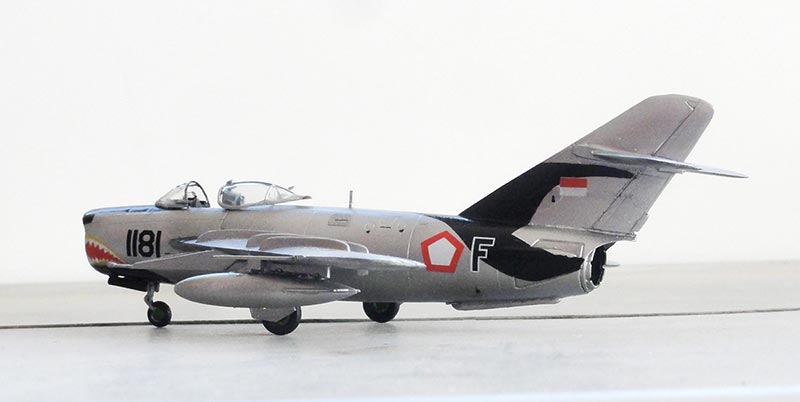
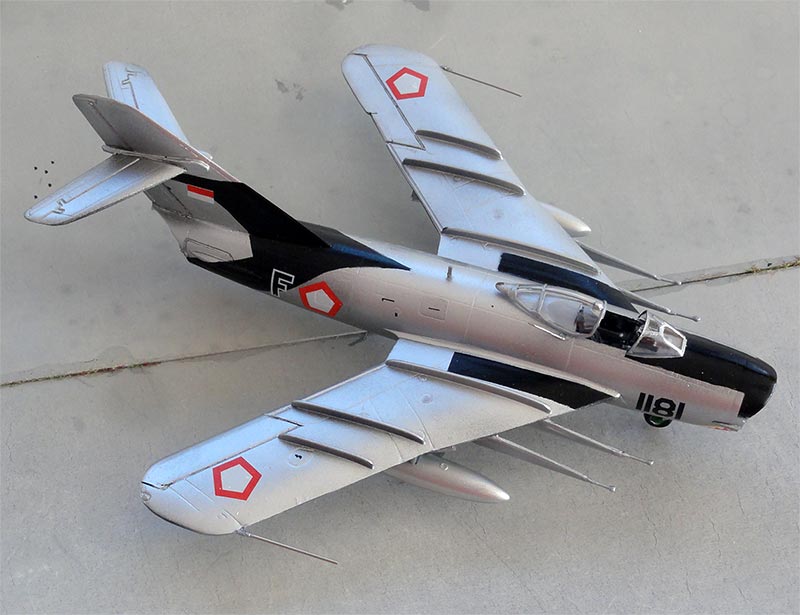
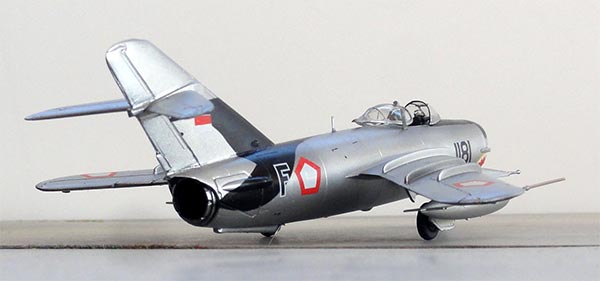
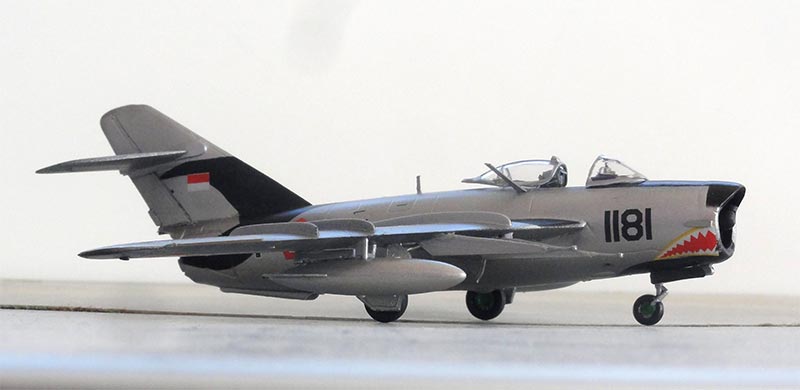

... and set at the Tabing base at Padang, West Sumatra. It is now known as the Sutan Sjahrir Air Force Base, named after Indonesia's first prime minister.
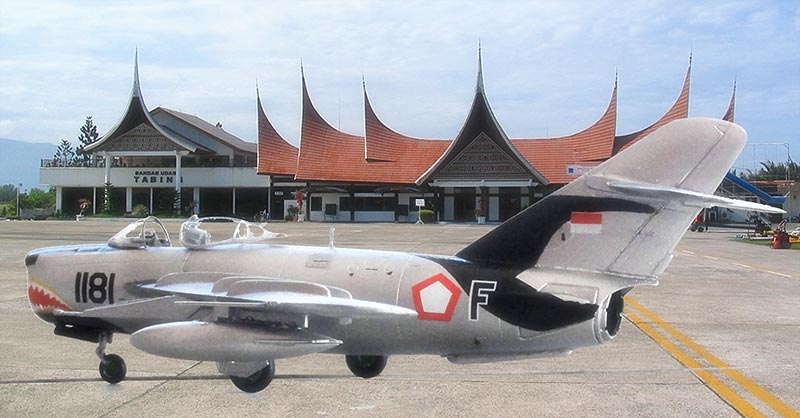
The third ZTS Plastyk 1/72 kit was made as a MiG-17 "Fresco A" of the Afghanistan air force, so that needed a conversion. At the time I did not have a reasonable MiG-17F kit in 1/72.
The Royal Afghanistan air force got from the USSR from 1957 various MiG-17 aircraft with and without afterburner, so "Fresco A, Fresco C and D" types. Hidecal line set #72030 decal set was used. Bort number "106" could not be checked by me in any reference book but is claimed to be an early MiG-17 "Fresco A".
The main improvements also with this kit were also done as noted above....
But also for the "Fresco A" conversion....
(1) this version has a simple nose air intake without radar fairing. At that time, I did not bother to removed a 2 mm slice of the kit's PF nose section, some sanding at the nose ring was only done. So the kit PF nose fairing was sanded in a curved streamlined shape, just keeping a small gun camera knob. (on hind sight, a bit extra effort could have been done here).
(2) the "Fresco A" version does not have the engine with afterburner and a slimmer rear fuselage tail end. So for this kit the exhaust pipe cross section was made smaller. As the fin of the kit was also corrected (see above), the open gaps allow to make the end slimmer. With some bending of the rear fuselage section and puttying and sanding this can be done.
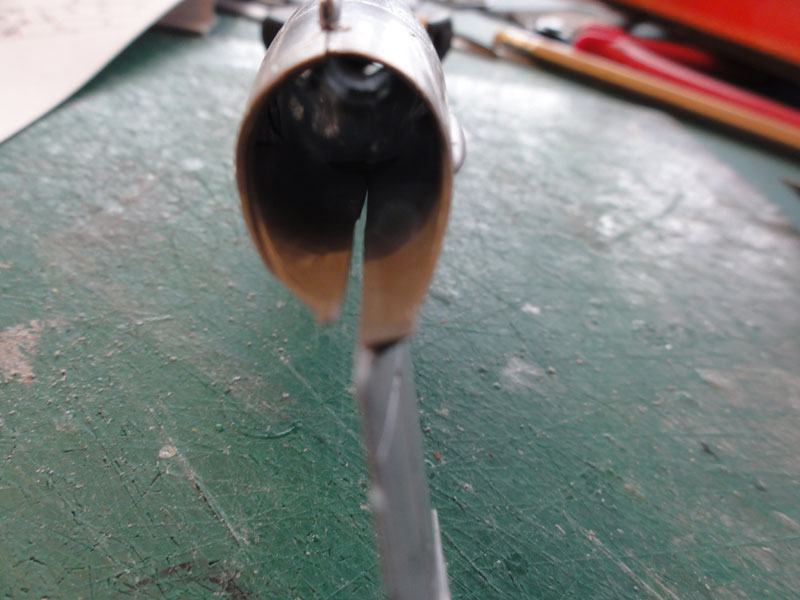
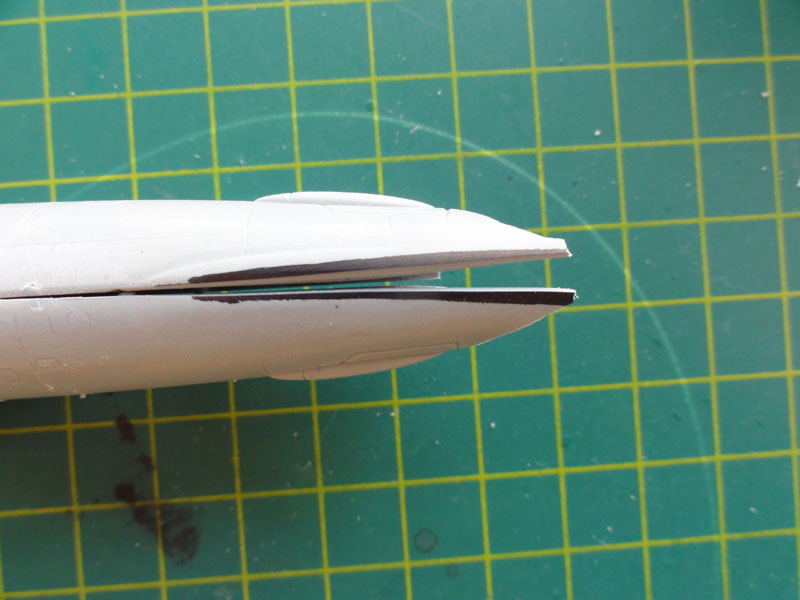
The exhaust part #10 was also cut open and sanded smaller. I also added a jet pipe from a bit found in the spares box.
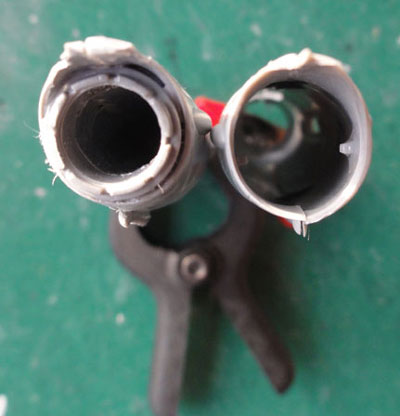
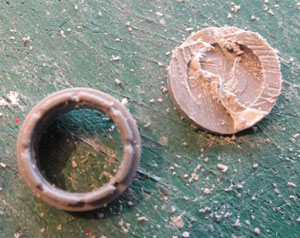
This look more now a "Fresco A" fuselage tail end.
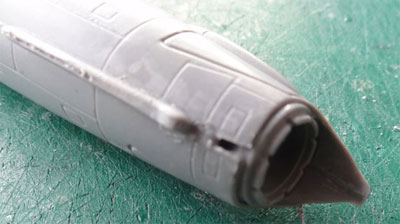
(3) "Fresco A" also has a rectangular shaped pair of smaller air brakes so some rescribing done of the air brakes at the fuselage to represent better the real ones. And a structural fairing added.
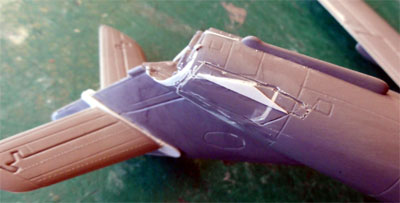
That completes the corrections and conversion.
The overall scheme is a natural metal finish, which is a sort of "alodine" which gives the natural metal some different variations. I used the ALCLAD approach with a gloss black undercoat followed by ALCLAD Aluminium.
As on most MiG-17's, the cockpit interior is mid grey as are gear bays and legs. I did not know at the time, so painted them incorrectly.
The canopy of the MiG-17F should be the standard one (so not with the extra PF horizontal frames). I did not have a F canopy at the time so sanded the kit part a bit shorter and hid the frames with paint. (tip: if you have the Airfix kit, you can now use their spare canopy for a MiG-17 F if desired).
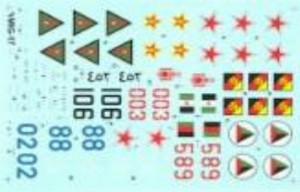
Decals came from Hidecal Line set #72030. To get a bit weathered effect, some aluminium was also airbrushed over the roundels and "bort" nose numbers.
The model was completed as described above and got a gloss varnish airbrushed with Johnson Future / Pledge to get an even sheen and protect the decals.
The model is not perfect but I was happy with it in those days.
AFGHANISTAN
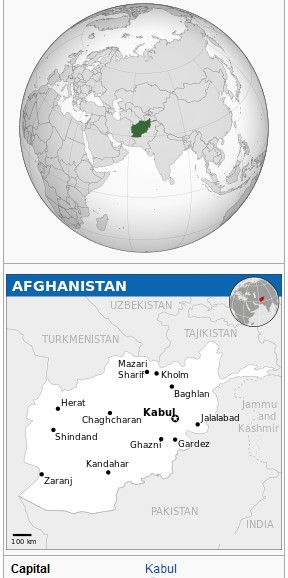

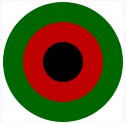

 < old
< old Afghanistan
 .
. 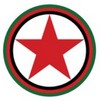 .
.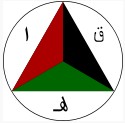

[ area 652.000 sq.km | capital: Kabul | population 32 million | GDP USD 700 per inhabitant nom.]
Afghanistan was part of the British Indian area at the end of the nineteen century but declared independence in February 1919. The Afghan air force as part of the army was set up in 1924 with the reign of King Khan with some Polikarpov R-1 (DH-9A) aircraft and Junker transports. There were conflicts and civil wars. After the Second World War the air force became the "Royal Afghan Air Force" and also flew Avro Ansons and some Yak-11 and Yak-18. The Soviet Union supplied from 1957 dozens of MiG-17 "Fresco A", "Fresco C" and PF "Fresco D" interceptors with a few MiG-15 UTI trainers. The main base was at Mazar e Shariff. In 1965 some 18 second hand MiG-19S fighters were delivered and from 1969 some Il-28 Beagle bombers. In 1973 a revolt resulted in establishment of the Afghan Republic and some 40 MiG-21 F13 fighters supplied as well as many Antonov transports. Trainers were also some Aero L-39. A communist regime was more formerly established in 1978 after a revolution. But there were rebellions of Mujahideen which were hard to control in the vast rugged mountains. In 1979 the Soviets sent ground troops and air power. In those years the Soviet Union supplied aircraft to the "Democratic Republic of Aghanistan Air Force"; many were flown by Warsaw pact pilots. They had at a time no less than 100 combat aircraft, 50 mostly Antonov transports and some 150 mostly Mil helicopters. From 1979 at least 70 additional MiG-21 MF were obtained and 50 MiG-21bis along with some UM trainers. Probably also some MiG-21FL and/or PFS and/or PFM were supplied. It is also believed that MiG-23 Floggers were supplied and some Sukhoi SU-7, SU-17/20 and SU-22 fighter bombers in the mid 1980s.
The Soviets with drawed from the Afghan war in 1989, leaving a weak government. Taliban groups seized more and more control in areas with interference from different islamic groups and countries. Najibullah's regime fell in 1992. In 1996 an Islamic Emirate was declared and some MiGs even used by their armed militia forces. But in fact the air force seized to exist.
Local terrorist groups emerged and also started to fight against Western influences with the terrible 9/11 attacks in the USA. US armed forces were sent along with forces from a Western coalition to Afghanistan in "Operation Enduring Freedom". A local supported Western oriented but Islamic government was established.
The Afghan air force is being built-up with Western aircraft like 4 C-130 transports, some 30 Cessna's, 18 Pilatus PC-12 and for interdiction roles some 24 EMBRAER Super Tucano's. Helicopters in use are 29 MD-500/ MD-530 helicopters and still many Mil helicopters. Main bases are at Kabul, Kandahar, Mazar e Shariff and Shindand.
But still the Taliban controls most of the Afghanistan which is still unstable for more than 50 years. With the withdrawal of the USA and NATO September 1 2021, the situation will drastically change.
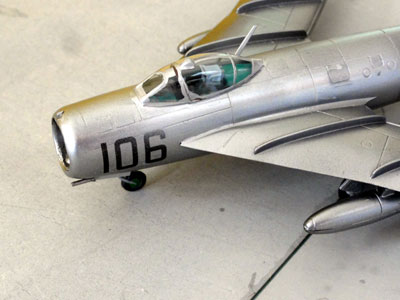
Note the changed model nose intake shape, just retaining a small gun camera knob. On hind sight, it still is a bit "too fat".
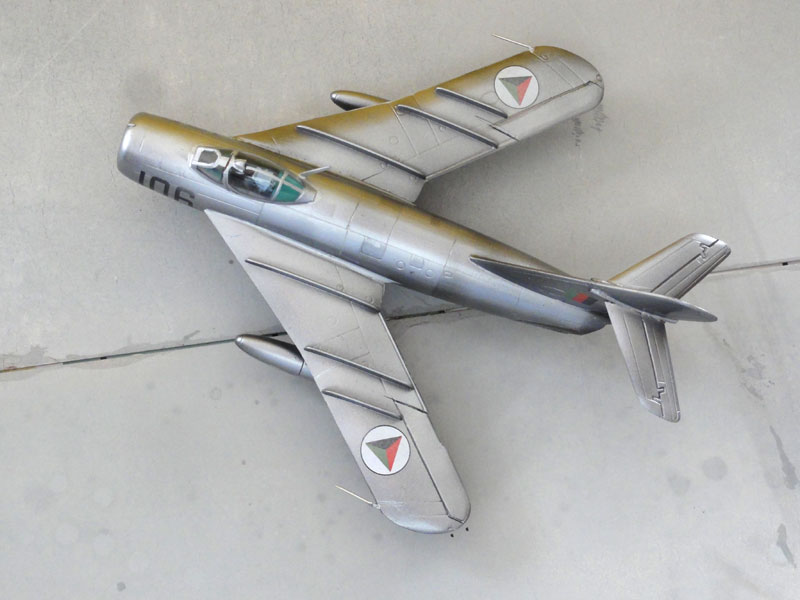
MiG-17 "Fresco A" with no Bort 106, Royal Afghanistan Air Force, Mazar e-Shariff base, 1960.
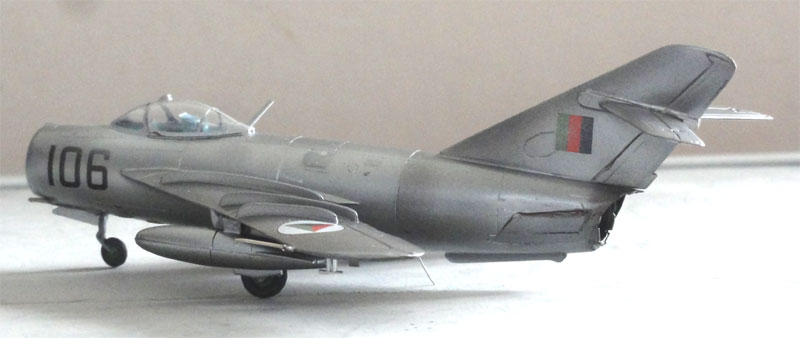
(...oops.... found out later that the model had not enough nose weight added... so a piece of wire keeps it horizontal...)
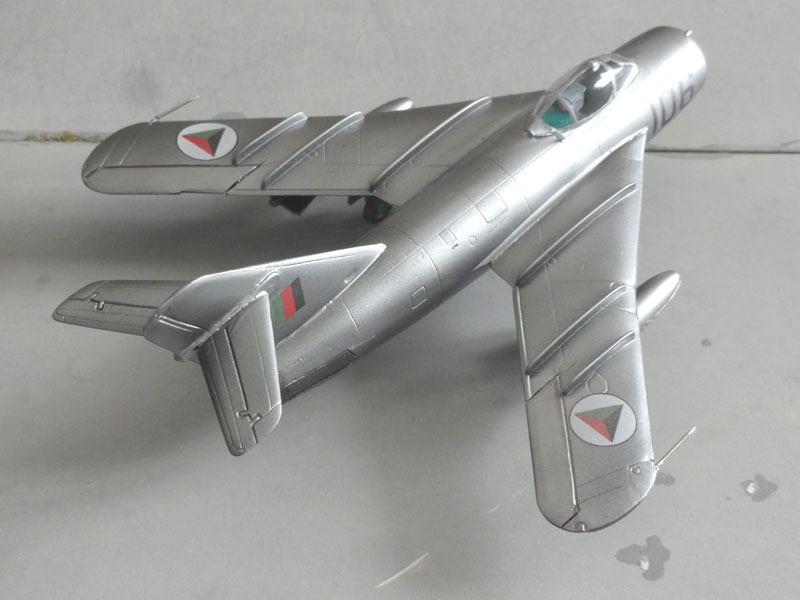
Currently, Mazar e-shariff is a large base in the North of Afghanistan.
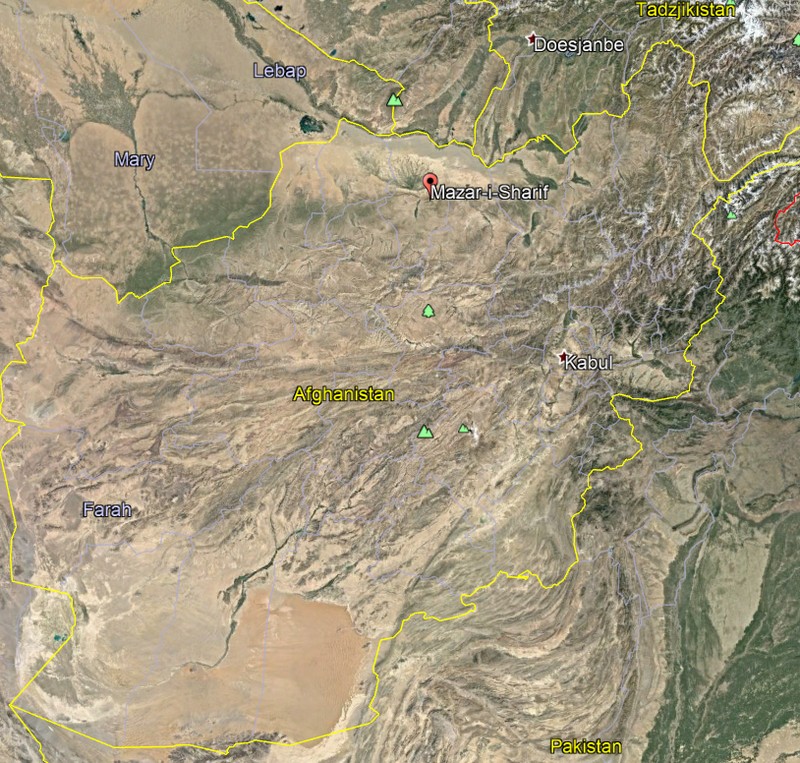
Detail of the air base
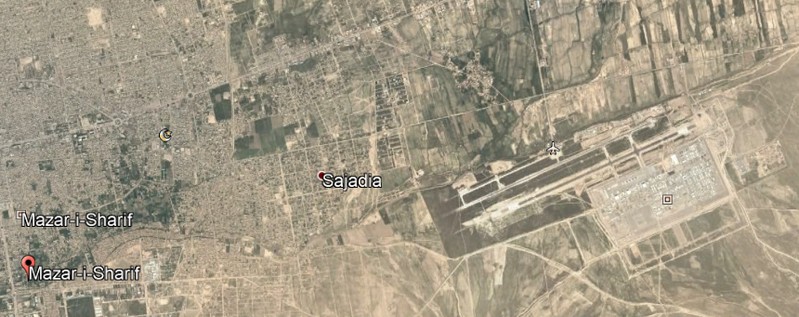
The photo here shows a Google Earth 2020 photo of the aircraft scrap yard. The MiG-17 is long gone, but is shows a MiG-21, Sukhoi Fitter and some transports.
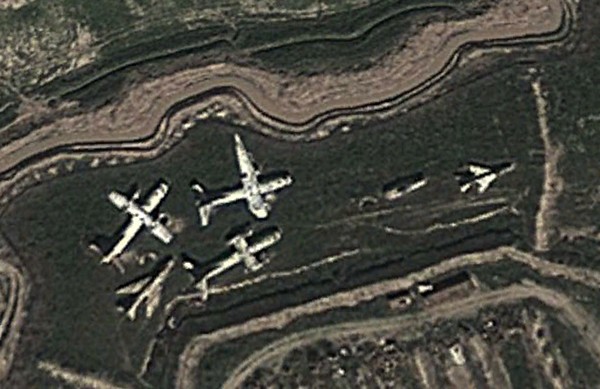
On to next [ Page 3... ]
Back to 1/72 Models.......

(c) Copyright Meindert "designer"/ All rights reserved. Your comments are welcomed by webmaster
Created this page
July 12, 2020